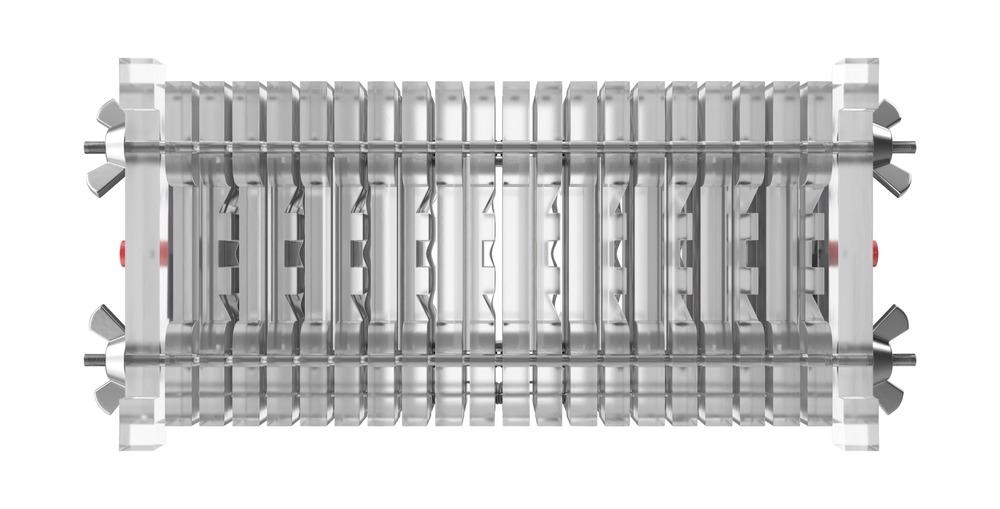Writing in the journal ACS Applied Energy Materials, a team of scientists from Chongqing University in China has reported the development of high-performance anion exchange membranes based on PVA. The research aims to overcome one of the main bottlenecks in commercializing these materials for use in fuel cells.

Study: Anion Exchange Membranes Synthesized by Acetalization of Poly(vinyl alcohol) for Fuel Cells. Image Credit: PixelSquid3d/Shutterstock.com
Alkaline Anion Exchange Membranes
Anion exchange membranes have attracted research attention in recent years due to their low cost and potential commercial use in fuel cell technologies. The function of these membranes is mainly for hydroxide ion conduction and reaction gas isolation. Currently, however, there are some performance issues that hinder the commercialization of anion exchange membranes, such as their stability and conductivity.
Two main fabrication routes for anion exchange mechanisms are currently used. These materials can be produced by either polymerization of monomers or polymer modification. Both fabrication routes are suitable for membrane synthesis. For instance, polymerization is conducive to molecular design and can easily introduce functional groups into anion exchange mechanisms to improve their properties.
Commercial polymer modification has also been widely studied in recent years. Studies have modified various commercial polymers such as poly(olefins,) poly(sulfones,) and poly(aryl ether ketone). Polymer modification processes can be used to brominate benzyl groups. However, there are issues with some of these processes due to the use of hazardous reagents and poor alkaline stability.
Synthesizing PVA-based Anion Exchange Membranes
Recent research has demonstrated the beneficial properties of PVA to fabricate anion exchange membranes. This natural polymer possesses a large number of reactive hydroxyl groups in its backbone, which is highly advantageous for the production of these membranes. Furthermore, PVA displays excellent alkaline stability.
Early attempts to use PVA for anion exchange mechanisms involved using epoxy groups to modify the structure of PVA and use grafting to introduce cationic groups. However, these modified polymers suffer from conductivity and ion-exchange capacities due to inefficient hydroxyl substitution.
To overcome this issue, researchers attempted to enhance the conductivity of these membranes by incorporating ion conductors such as quaternized silica and potassium hydroxide. However, issues persisted with poor film-forming capabilities and ion conductor losses.
The Study
The paper in ACS Applied Energy Materials has proposed a novel approach to fabricating PVA-based anion exchange membranes. The authors have synthesized an alkaline-functionalized molecule and grafted it onto the backbone of PVA via an acetylation process.
The performance of the prepared exchange membrane was evaluated in the research, with properties such as ionic conductivity, water absorption, and mechanical properties analyzed in detail. Additionally, the authors have provided an in-depth characterization of the material’s morphology.
NMR and FTIR spectroscopy were employed by the authors, along with thermogravimetric analysis. The prepared PVA-based anion exchange membrane’s morphology was investigated using scanning electron microscopy. Both the membrane surface and cross-sectional morphology was analyzed in depth. A universal materials testing machine was employed to evaluate the membrane’s mechanical properties.
To provide information on the membrane’s water uptake and swelling ratio, samples were tested both before and after water absorption. The length and weight of membranes pre- and post-water absorption were measured to provide experimental data.
Ionic conductivity was measured using the two-electrode method. An alternating current impedance analyzer was employed to test this property. Conductivity was measured every 24 hours at 25 oC. The prepared membrane was soaked in a 1 M potassium hydroxide solution to evaluate its stability under alkaline conditions.
Study Findings
Experimental results and analysis demonstrated that the prepared PVA-based anion exchange membranes possess several beneficial properties. They display excellent OH- conductivity at 80 oC (up to 200 mS cm-1.) Using crosslinking agents led to controlled swelling of the membranes whilst maintaining superlative water uptake. Up to 314.6 wt% water uptake was observed.
Alkaline resistance tests demonstrated a 70% retention of hydroxyl ion conductivity after 168 hours in the membranes. Moreover, incorporating the membrane into a fuel cell achieves an outstanding peak power density at 65 oC of 982 mW cm-2.
In Summary
The research has demonstrated the development of a functionalized PVA-based anion exchange membrane for use in next-generation fuel cells. Thorough analysis and characterization of several key properties which influence the performance of these fuel cell components have been performed by the authors.
Study results have demonstrated that these membranes, prepared via an acetylation route, are advantageous candidates for improving the efficiency of fuel cells, a key technology in the drive toward carbon neutrality and the mitigation of anthropogenic climate change.
Further Reading
Chen, Y et al. (2022) Anion Exchange Membranes Synthesized by Acetalization of Poly(vinyl alcohol) for Fuel Cells ACS Applied Energy Materials [online] pubs.acs.org. Available at: https://pubs.acs.org/doi/10.1021/acsaem.2c01217
Disclaimer: The views expressed here are those of the author expressed in their private capacity and do not necessarily represent the views of AZoM.com Limited T/A AZoNetwork the owner and operator of this website. This disclaimer forms part of the Terms and conditions of use of this website.